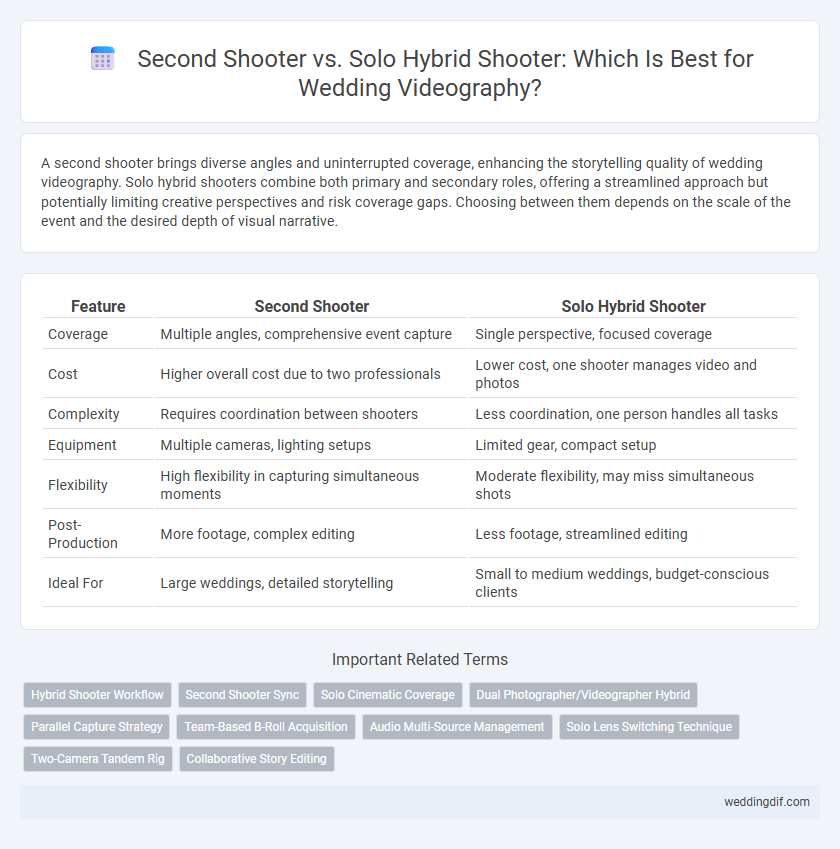A second shooter brings diverse angles and uninterrupted coverage, enhancing the storytelling quality of wedding videography. Solo hybrid shooters combine both primary and secondary roles, offering a streamlined approach but potentially limiting creative perspectives and risk coverage gaps. Choosing between them depends on the scale of the event and the desired depth of visual narrative.
Table of Comparison
| Feature | Second Shooter | Solo Hybrid Shooter |
|---|---|---|
| Coverage | Multiple angles, comprehensive event capture | Single perspective, focused coverage |
| Cost | Higher overall cost due to two professionals | Lower cost, one shooter manages video and photos |
| Complexity | Requires coordination between shooters | Less coordination, one person handles all tasks |
| Equipment | Multiple cameras, lighting setups | Limited gear, compact setup |
| Flexibility | High flexibility in capturing simultaneous moments | Moderate flexibility, may miss simultaneous shots |
| Post-Production | More footage, complex editing | Less footage, streamlined editing |
| Ideal For | Large weddings, detailed storytelling | Small to medium weddings, budget-conscious clients |
Understanding the Roles: Second Shooter vs Solo Hybrid Shooter
A second shooter in wedding videography specializes in capturing complementary angles and moments alongside the lead videographer, enhancing coverage with multiple perspectives. A solo hybrid shooter combines both principal and supporting roles, managing all video aspects independently while often also handling photography duties. Understanding these roles helps couples decide between broader coverage with a team or a streamlined approach with one versatile professional.
Key Responsibilities at a Wedding
A second shooter in wedding videography focuses on capturing complementary angles, candid moments, and detailed shots that the solo hybrid shooter might miss, ensuring comprehensive coverage of the event. The solo hybrid shooter combines both primary videography and photography duties, balancing ceremony documentation with creative storytelling through video and stills. Understanding these key responsibilities helps in deciding between specialized teamwork or versatile single-person coverage for wedding cinematography.
Coverage and Angles: Maximizing the Moment
A second shooter in wedding videography expands coverage by capturing multiple angles simultaneously, ensuring no significant moment is missed and enhancing the storytelling depth. Solo hybrid shooters often rely on repositioning quickly to cover diverse perspectives, which can sometimes lead to gaps in capturing simultaneous key events. Utilizing a second shooter maximizes moment coverage and angle variety, providing a richer, more dynamic wedding video.
Flexibility and Adaptability on the Wedding Day
A second shooter provides unmatched flexibility and adaptability on the wedding day by capturing diverse angles and spontaneous moments that a solo hybrid shooter might miss while juggling both videography and photography. Solo hybrid shooters offer a streamlined approach but often face challenges in covering simultaneous critical events due to limited personnel. Hiring a dedicated second shooter ensures comprehensive coverage and dynamic storytelling through efficient multitasking and strategic positioning.
Equipment Demands for Each Approach
Second shooters in wedding videography typically require more specialized equipment such as additional cameras, lenses, and audio gear to capture multiple angles simultaneously. Solo hybrid shooters balance the need for versatile, lightweight equipment that supports both photography and videography, often relying on all-in-one cameras, gimbals, and compact audio solutions. Equipment demands significantly influence workflow efficiency and the final coverage quality in each shooting style.
Creative Collaboration vs Individual Vision
A second shooter on wedding videography teams brings creative collaboration that enhances storytelling by capturing multiple perspectives, resulting in dynamic, multifaceted footage. A solo hybrid shooter focuses on an individual vision, blending cinematography and photography to maintain a consistent artistic style and narrative. Choosing between them depends on prioritizing either collaborative creativity or unified, singular direction for the wedding day's visual documentation.
Workflow and Post-Production Differences
A second shooter enhances wedding videography workflow by capturing multiple angles simultaneously, enabling more dynamic storytelling and reducing coverage gaps. Solo hybrid shooters manage both primary footage and audio, streamlining on-set decision-making but increasing post-production time due to extensive sorting and syncing of clips. Workflow for second shooters typically involves collaborative editing sessions, while solo hybrids require meticulous organization to balance shooting and editing efficiency.
Client Experience and Interaction
A second shooter enhances the client experience by capturing diverse angles and candid moments, allowing the primary videographer to focus on directing and engaging with the couple. Solo hybrid shooters offer a more personalized interaction, building a closer rapport with clients through direct communication and consistent presence throughout the event. Clients often appreciate the collaborative dynamic of a second shooter for comprehensive coverage, while some prefer the intimacy and streamlined experience provided by a solo hybrid approach.
Cost Implications for Couples
Choosing a second shooter for wedding videography typically increases costs by 30% to 50%, reflecting the added coverage and diverse angles captured. Solo hybrid shooters offer a more budget-friendly option, combining photography and videography, often reducing overall expenses by 20% compared to hiring separate professionals. Couples balancing cost and coverage benefits must consider their priorities for cinematic variety versus cohesive storytelling within their wedding budget.
Choosing What’s Best for Your Wedding Story
Selecting between a second shooter and a solo hybrid shooter impacts the depth and variety of wedding videography coverage. A second shooter provides multiple angles and moments captured simultaneously, enhancing storytelling complexity. In contrast, a solo hybrid shooter balances videography with photography, offering a cohesive narrative suited for more intimate or budget-conscious weddings.
Second Shooter vs Solo Hybrid Shooter for weddings Infographic

 weddingdif.com
weddingdif.com